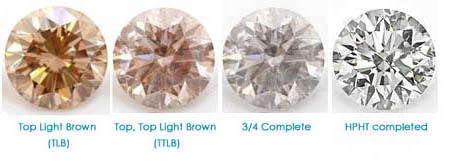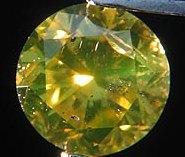HPHT Treated Diamonds
PHT stands for high pressure, high temperature. HPHT is applied to the few diamonds that are not fully crystallized (“premature diamonds”) when released from fiery, erupting volcanoes. The process is a carefully controlled, scientific procedure where high pressure and high temperature is used to finish what Nature started by applying the same atmospheric pressure (70,000 atmospheres) and temperature (3,682°F) conditions required to bring a diamond to its fully “mature” state.

The HPHT process involves gemologists carefully positioning a diamond in a “containment cube” that is surrounded by heating mechanisms. The cube is then placed in a press to apply the same amount of pressure the earth creates when forming diamonds. As you can imagine, these multi-million dollar facilities are very sophisticated and are centered around an enormous computer controlled diamond press. HPHT mimics the exact same conditions that occur in the volcanic environments where diamonds are found. This process brings a candidate diamond to its most mature, desirable, colorless state. Mature diamonds are defined as those that show a highly coveted D, E, F, G or H color grade. the HPHT process simply finishes what nature started and diamond maturation process is permanent. Even though heat and pressure is applied to bring a natural, high clarity, top light brown (TLB) or top, top light brown (TTLB) to a white color grade, it is important to note that these diamonds are not synthetics.
Only superior grade, Type 2 a, TLB and TTLB diamonds are candidates for HPHT. These diamonds must have clarity grades of FL-VVS2 the highest clarities available, because the extreme pressure and temperature can cause diamonds with inclusions or fractures to explode during the process. NOTE: HPHT diamonds are not treated diamonds. HPHT diamond processing does not involve chemicals, are not irradiated or coated.
What are the benefits of buying an HPHT diamond?
The major benefit of buying an HPHT natural diamond is having the ability to purchase the highest clarities and white diamonds with savings from 45-68%.

Concerns:
With many consumers wanting to purchase the “biggest and best” diamond, the demand for HPHT diamonds grew. These enhanced stones allow consumers to get a larger stone with better color for less than what they would pay for a natural diamond of the same specifications—but at what cost? Purchasing HPHT diamonds is not recommended for several reasons. These enhanced stones can show hints of color that is visible from the side of the stone upon close inspection. They also tend to lose some of their original weight and clarity during the process. Even more concerning is that HPHT diamonds tend to be magnetic and some can even be picked up by magnetic force! because the extreme pressure and temperature can cause diamonds with inclusions or fractures to explode during the process.

GIA Report :
It’s difficult to distinguish natural diamonds from HPHT stones, so some consumers inadvertently purchase enhanced diamonds thinking they are real. The Gemological Institute of America (GIA) wanted to remedy this situation to help prospective buyers truly know whether they were looking at a natural or enhanced stone. A team, led by the GIA’s director of research, Dr. Wuyi Wang, put diamonds through a barrage of tests to indicate whether they were natural or not. They discovered that in order to differentiate the HPHT from the natural diamonds, advanced spectroscopic techniques needed to be used. An instrument called the DiamondView is used to detect synthetic diamonds by looking for unique spectroscopic telltale features like a lack of natural graining in the stone.
Conclusion:
Many companies around the globe are experimenting with HPHT treatments, and not all are marking these enhanced stones with proper identification. Therefore, it is becoming more and more difficult for industry professionals and GIA researchers to differentiate between HPHT and natural diamonds. Researchers at the GIA continue to develop new techniques to identify HPHT gems, but keeping up with the developing technology is challenging. In a press release, GIA representatives said HPHT diamonds “can be detected only at knowledgeable, experienced, fully-equipped gemological laboratories. Unfortunately, it is not yet possible to conclusively identify all HPHT-treated diamonds, although we believe that the vast majority are detectable by a well-equipped laboratory with qualified staff and extensive gemological data to reference.”
